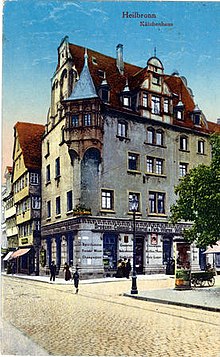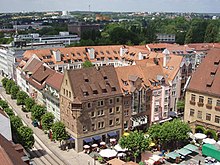Käthchenhaus
The Käthchenhaus is a private secular building from the 14th century on the market square in Heilbronn . The house with the striking bay window on the corner of Marktplatz and Kaiserstraße was given its current name in the 19th century from the then popular play Das Käthchen von Heilbronn .
history
In the past, the Käthchenhaus was simply called Steinhaus , because, unlike most other buildings in the city, it was built from top to bottom from solid Heilbronn sandstone . Its building history is practically unknown. In any case, the building must have been built by a "very rich" Heilbronn citizen of the 14th century.
The reformer Johann Lachmann is said to have lived here in the 16th century , which is why it was also called Lachmann's House . The reformer is assigned the task of designing the bay window with relief images of four prophets. The house was later also called Weingand'sches Haus , and in the 16th century the Hüngelin family became the owners. In the 16th century the Reichsschultheiße and the Syndicus are said to have lived in the building.
Neither Käthchen von Heilbronn , a fictional character from Heinrich von Kleist 's play of the same name from 1808, nor any of her presumed historical models were at home in the building. Nevertheless, the Käthchen was to give the building its name when the city gained further fame in the 19th century for its popular drama.
In 1919 the building became the property of August Dietsche, a businessman from Karlsruhe, who restored the house and opened a specialty shop for household and kitchen appliances there. Another renovation took place in 1934, whereby a Renaissance gable came to light under the plaster. During the air raid on Heilbronn on December 4, 1944, the building was badly damaged: the roof and the inside of the house were completely burned, only the stone facade was preserved. Again under Dietsche there was another restoration until 1949, whereby the roof and gable construction in particular was only reconstructed in a very simplified manner. The baroque gable facing the market square was completely omitted during the reconstruction. The ground floor was designed as a simple commercial space, where the owner ran his household goods business for a few years before renting the ground floor to a supermarket chain. After this lease expired in 2005, a café moved into the commercial space.
Today the building, which is still owned by the heirs of the merchant Dietsche, forms the southeast corner of the Käthchenhof . The second floor of the Kätchenhaus with the distinctive bay window has been rented to the men's association " Schlaraffia Heylbronnen " since the 1950s and cannot be visited.
description
In the style of medieval residential towers , this building consists of three floors, made entirely of sandstone with walled-up windows from the Gothic period and others from the Renaissance period . On the bay window, which was designed by Balthasar Wolff in 1534, half-length portraits of the four biblical prophets Isaiah , Jeremiah , Hosea and Habakkuk are shown.
Isaiah
As Israel's first prophet, Isaiah promised the Israelites a future Messiah as a righteous judge and savior of the poor. The inscription
- “ JESAIAS 5 C 23 VAE QVI JVSTIFICATIS IMPIVM PRO MVNERIBVS ”
is a quote from the book of Isaiah:
“ 22 Uae […] 23 […] qui justificatis impium pro muneribus,”
" 22 Woe to those [...] 23 [...] who speak righteous to the wicked because of a bribe,"
Jeremiah
Along with Isaiah, Jeremiah is a great scriptural prophet of the Tanakh . The following inscription can be read on the bay window:
- “ HIEREMIAS 5 CA IVDICIVM PAVPEVM NON IVDICAVERVNT ”,
taken from the book of Jeremiah:
“Judicium pauperum non judicaverunt.”
"They do not enforce the legal rights of the poor."
Hosea
The book of Hosea opens the series of the Twelve Minor Prophets in the Tanakh . Like later Jeremiah ( Jer 31.20 EU ) and Isaiah ( Isa 63.15 EU ), Hosea also emphasized God's passion for his unfaithful people and his sympathy for their fate up to and including “pain” ( Hos 11.8 EU ). The inscription on the bay window:
- " HOSEAS 4 C NON EST VERITAS I ~ EC MIA MIVVS CIENCIA TER "
reproduces the following verse in abbreviated form:
"Non est enim veritas, et non est misericordia, et non est scientia Dei in terra."
"For there is no truth and no love and no knowledge of God in the land."
Habakkuk
Habakkuk issued woes about greedy, exploiters, violent people and idolaters ( Hab 2.6–20 EU ). The inscription
- " HABACVC I CA INPIVS ARCET AT & CIRCVNDAT PIVM ",
roughly with the meaning “The wicked takes advantage of the righteous”, goes back to the beginning of the first chapter of the book of Habakkuk, but is not found there literally. For example at Habakuk one reads:
“Quia impius prævalet adversus justum, propterea egreditur judicium perversum.”
“For the wicked surrounds the righteous; that's why twisted law comes out. "
reception
The neighboring Käthchenhof building complex was named after the Käthchenhaus.
swell
- ↑ History of the City of Heilbronn - City History Part 1: 741 to around 1803 (by Christhard Schrenk): The Heilbronn bankers, the so-called “Kawerschen” from southern France and merchants from Asti, Italy, could be considered as “very rich” Heilbronn citizens of the early Middle Ages.
- ↑ Oberamtsbeschreibung Heilbronn 1904
- ↑ The bay window at the Käthchenhaus Swabia and Franconia: Local history supplement to the "Heilbronner Voice" Saturday, May 7, 1955
Web links
Coordinates: 49 ° 8 ′ 31.8 ″ N , 9 ° 13 ′ 5 ″ E







